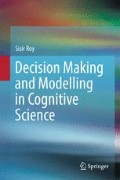Abstract
Since the very inception of quantum theory, the corresponding logic for quantum entities has attracted much attention. The logic underlying the quantum theory is shown to be non-Boolean in character. Boolean logic is a two/valued logic which is used for the description of everyday objects. Modern computers are based on this logic. The existence of an interference term for microscopic entities or quantum entities clearly indicates the existence of three-valued or non-Boolean logic. This is popularly known as quantum logic. It is mathematically shown that a set of propositions which satisfies the different axiomatic structures for the non-Boolean logic generates Hilbert space structures. The quantum probability associated with this type of quantum logic can be applied to decision-making problems in the cognitive domain. It is to be noted that, until now, no quantum mechanical framework is taken as a valid description of the anatomical structures and functions of the brain. This framework of quantum probability is very abstract and devoid of any material content. So it can be applied to any branch of knowledge like biology, social science, etc. Of course, it is necessary to understand the issue of contextualization, i.e., here, in the case of the brain.
The only acceptable point of view appears to be the one that recognizes both sides of reality—the quantitative and the qualitative, the physical and the psychical—as compatible with each other and can embrace them simultaneously.
—Pauli (1955: 208).
Access this chapter
Tax calculation will be finalised at checkout
Purchases are for personal use only
References
Aristotle (born 384 bce, Stagira, Chalcidice, Greece—died322, Chalcis, Euboea); http://www.britannica.com/EBchecked/topic/34560/Aristotle
Birkhoff Garret; Von Neumann, John (1936) Annals of Mathematics; 37 (4): 823–843.
Bell, J.L. (1986) Brit. J. Phil.Sci.; 37, 83-99.
Engesser, K, Gabbay, D.M. & Lehman, D. (2011); “Handbook of Quantum Logic and Quantum structures: Quantum Structures”; Eds. by Kurt Engesser, Dov M. Gabbay, Daniel Lehmann; Elsevier, Radarweg 29, PO Box 211,1000 AE Amsterdam, the Netherlands.
Friedrich, Jacob Fries (1773-1843); Chisholm, Hugh, ed. (1911). Fries, Jacob Friedrich; Encyclopædia Britannica; (11th ed.); Cambridge University Press.
Hacck, Susan(1978) Deviant Logic, Fuzzy Logic: Beyond the Formalism;The University of Chicago.
Hilbert David & Corant, Richard (1953); “Methods of Mathematical Physics”;Vol I, Interscience.
Husserel Edmond, Moran Dermut (2001) Logical Investigations, Vol.1, abridged; reprint; revised; Psychology Press.
Jauch, J.M. & Piron, C. (1969) On the structure of quantal Proposition systems; Helvetica Physica Acta; 36, 827-837.
Mill, John Stuart (1806-1873) Bulletin of Symbolic logic; 19 th century Logic Between Philosophy and Mathematics; 6(04); Dec 1999; 433-450;
Mill, J. Stuart (1806-1873) On Liberty and other Writings; (Extends the 1974 Deviant Logic, with some additional essays published between 1973 and 1980, particularly on fuzzy logic, cf. The Philosophical Review, 107: 3, 468–471.
Payne, J.W., Bettman, J.R. & Johnson, E.J. (1992) Behavioral decision research: A constructive processing perspective; Annual Review of Psychology, 43, 87-131.
Putnam, H. (1974) How to think quantum-logically”; Synthese, 29, 55-61. Reprinted in P. Suppes (ed.); Logic and Probability in Quantum Mechanics (Dordrecht: Reidel, 1976); pp. 47-53.
Simon Herbert (1957); 1957. “Models of Man”; John Wiley; ibid; (1972); (with Allen Newell): “Human Problem Solving”; Prentice Hall, Englewood Cliffs, NJ, (1972).
Simon Herbert, A. (1972); “Decision and Organization”; by C.M. Mcguire & Ray Radner (eds.); North Holland Publishing company
Author information
Authors and Affiliations
Corresponding author
Rights and permissions
Copyright information
© 2016 Springer India
About this chapter
Cite this chapter
Roy, S. (2016). Quantum Probability Theory and Non-Boolean Logic. In: Decision Making and Modelling in Cognitive Science. Springer, New Delhi. https://doi.org/10.1007/978-81-322-3622-1_7
Download citation
DOI: https://doi.org/10.1007/978-81-322-3622-1_7
Published:
Publisher Name: Springer, New Delhi
Print ISBN: 978-81-322-3620-7
Online ISBN: 978-81-322-3622-1
eBook Packages: Behavioral Science and PsychologyBehavioral Science and Psychology (R0)

